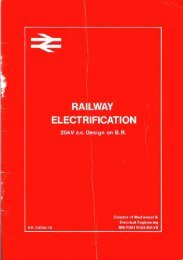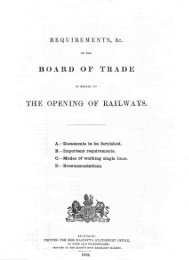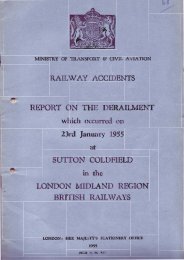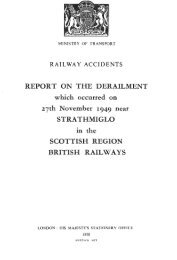R A I LT R AC K - The Railways Archive
R A I LT R AC K - The Railways Archive
R A I LT R AC K - The Railways Archive
You also want an ePaper? Increase the reach of your titles
YUMPU automatically turns print PDFs into web optimized ePapers that Google loves.
1<br />
144<br />
West Coast Main Line: London to Glasgow and Edinburgh continued<br />
Route characteristics<br />
DESCRIPTION This is the principal rail corridor linking the Channel Tunnel and<br />
London, the West Midlands, North West England, Glasgow and Edinburgh. <strong>The</strong><br />
route is electrified throughout, except from Bletchley to Bedford. <strong>The</strong> route is<br />
four track from London to Rugby (including the Northampton Loop) but beyond<br />
there is a mixture of two-, three- and four-track sections. Linespeeds vary but are<br />
predominantly 100–110mph on fast lines and 60–90mph on slow lines. <strong>The</strong><br />
southern end of the route was renewed and electrified in the 1960s and the<br />
northern end in the early 1970s.<br />
This route also encompasses the Primrose Hill–Watford DC lines,<br />
Watford–St Albans City, and Bedford–Bletchley. <strong>The</strong>se mostly have two<br />
tracks and Primrose Hill to Watford is also used by London Underground who<br />
operates services from Queen’s Park–Harrow.<br />
<strong>The</strong> volume of passenger and freight train movements on the route is very<br />
high. A number of route sections are operating near to capacity, the principal<br />
ones being London–Rugby, Coventry–Birmingham–Wolverhampton,<br />
Stockport–Manchester Piccadilly and the approaches to Glasgow.<br />
MAJOR STATIONS<br />
Birmingham New Street Station Regeneration Programme (SRP) work to<br />
the platforms and dispersal bridge area is currently in progress. This work is<br />
dramatically improving the platform environment as well as improving safety and<br />
fire precaution features, represents a commitment of about £19M and is due for<br />
completion during 1999/2000. <strong>The</strong> emerging station development plan includes<br />
many customer-reasonable requirements, such as new waiting lounges, improved<br />
ticketing and information facilities, and measures to reduce traffic congestion<br />
outside the main entrance.<br />
Route vision<br />
Our vision for the West Coast Main Line (WCML) is of a high-capacity highspeed<br />
route that caters for the needs of all its train operators and users.<br />
We are committed to delivering much shorter journey times, for example,<br />
London–Glasgow in 4 hours 12 minutes in 2002 and London–Manchester in<br />
1 hour 46 minutes in 2005.<br />
As part of the European high-speed rail network, the WCML is designated<br />
as a priority Trans-European Networks (TENs) project. This reflects its strategic<br />
importance. It links the major conurbations of North West England and Scotland<br />
to mainland Europe via the Channel Tunnel. It also forms part of the links<br />
between Britain and Ireland via a number of routes. We are applying for further<br />
funding from the European Union (EU) to support the implementation, having<br />
already succeeded in gaining grant aid for the development of the project.<br />
During the next six years, the route will be substantially upgraded to<br />
increase capacity and reliability, the latter including a reduced need for<br />
maintenance possessions. Work is being undertaken to increase the loading<br />
Glasg ow Central <strong>The</strong> largest single SRP scheme in Scotland, costing £35M,<br />
is at Glasgow Central, and involves upgrading the facilities for passengers and<br />
renewing the roof. <strong>The</strong> Argyle Street Bridge renovation received a special<br />
mention in the recent Ian Allan Heritage awards. In addition, we are reviewing<br />
the ability of the station to accommodate forecast passenger growth at this<br />
location, together with a number of customer-reasonable requirements, including<br />
improved waiting facilities.<br />
London Euston A further phase of SRP work has continued to be progressed<br />
in parallel with additional work on how the station should develop to<br />
accommodate the passenger growth forecast in the route strategy. Our<br />
Development Control Planning process has also embraced short-term<br />
improvements to some retail facilities on the concourse, along with the inclusion<br />
of customer requirements which primarily relate to new and improved waiting<br />
lounges, customer-information and help facilities.<br />
Manchester Piccadill y SRP work has continued with the gradual unveiling<br />
of the complete reglazing of the trainshed roof giving a foretaste of the<br />
transformation that this project will deliver at a cost of some £27M. In addition,<br />
we have undertaken further studies into the railway operating capacity<br />
requirements of this station and its relationship with the proposed urban<br />
regeneration of the surrounding areas being co-ordinated by Manchester City<br />
Council in partnership with Railtrack and others. Our Development Control<br />
Planning process takes account of a possible extension to the Metrolink and the<br />
desire to incorporate customer requirements – primarily the provision of new<br />
waiting lounges.<br />
gauge between Willesden and Motherwell to W10 gauge. Parts of the route will<br />
be capable of handling 750m-long freight trains. <strong>The</strong> infrastructure and control<br />
systems will support tilting trains travelling at speeds of up to 140mph.<br />
Much of the extra capacity and speed capability is underwritten by our<br />
agreement with Virgin Trains.<br />
Our West Coast Route modernisation (WCRM) scheme also ensures that<br />
all existing services to other customers who currently have contracted rights to<br />
operate over this route will be maintained. We are, however, aware that our<br />
customers also have a number of aspirations for additional services and reduced<br />
journey times throughout the route, for example between Edinburgh and<br />
Glasgow via Carstairs. We are working with our customers to reach agreement<br />
on these aspirations.<br />
In 2005, there will be at least ten high-speed trains per hour leaving Euston<br />
for destinations in the Midlands, North West England and Scotland. Additional<br />
high-speed paths will be available on ‘open access’.








